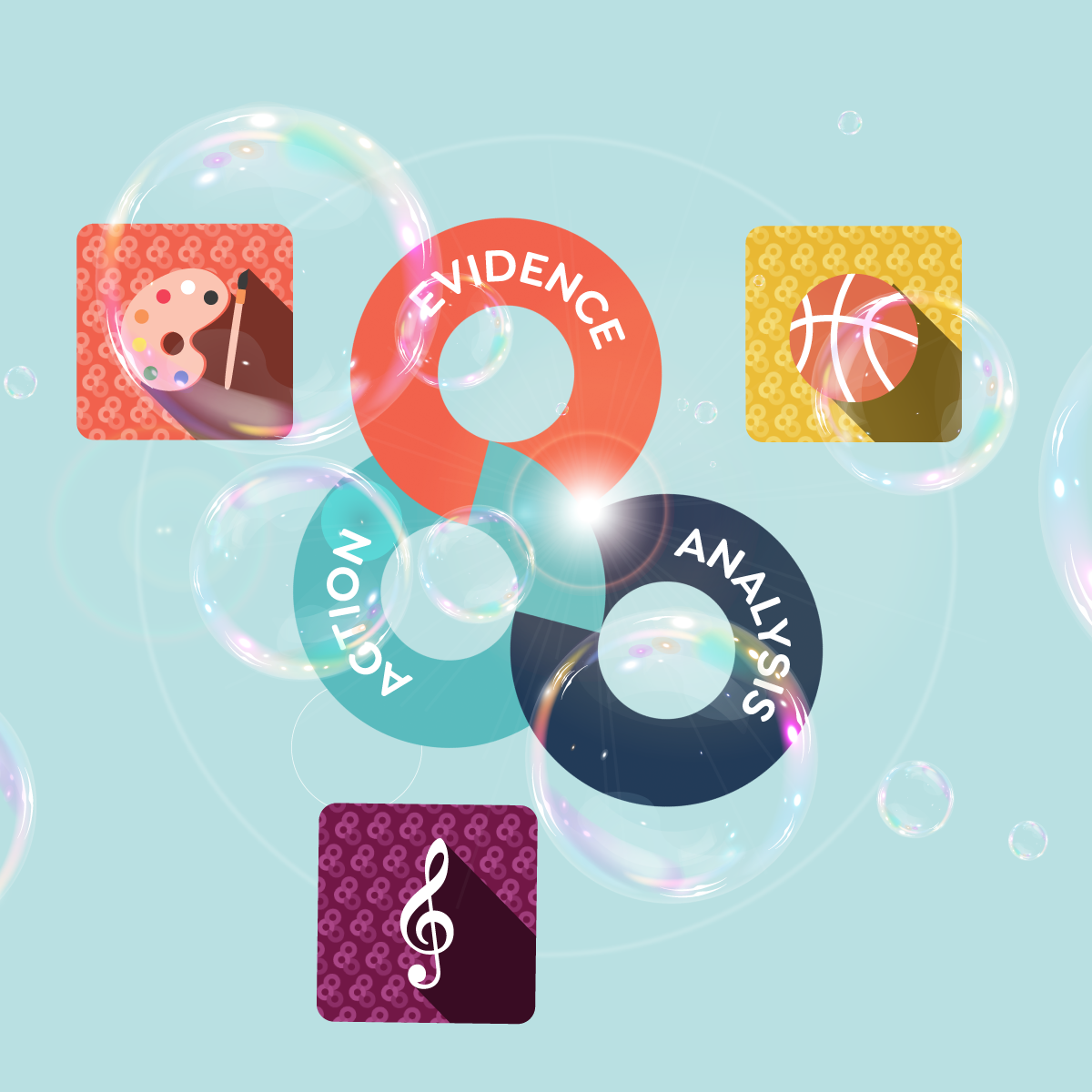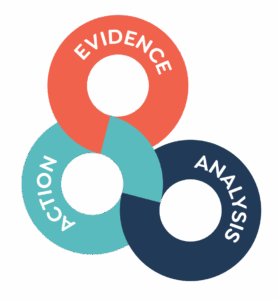Elective courses—arts, CTE, world languages, PE, journalism, robotics—are often “one‑teacher islands.” Performance and project work thrive here, but isolation makes it hard to calibrate quality, see impact, or iterate quickly. The solution is to unify around shared practices that grow learner agency—self‑assessment, peer assessment, goal setting, revision, reflection, and deliberate practice—anchored in clear success criteria and powered by the EAA cycle:
Evidence → Analysis → Action (with the metacognitive cycle humming underneath)
Plan → Monitor → Evaluate → Adjust.
Below is a practical playbook to launch (or relaunch) Impact Teams for electives—organized by EAA and tuned for performance/project‑based learning. Each section opens with a short context paragraph to set the stage.
Why Unify Around Practices?
Context. In electives, products differ wildly—a ceramics throw, a culinary plate, a monologue, a choreographic phrase, a podcast—but the learning moves that build agency are the same. When teams calibrate around the quality of self/peer assessment, goal setting, reflection, and deliberate practice, they can compare apples to oranges without losing fidelity. This shift reduces debate over which content standard to use and accelerates calibration on what students can do next to improve.
- Shared practice, diverse products. We judge the quality of learning moves across different media.
- Fewer detours about standards. Content standards still matter, but our common lens is dispositions and agency (persistence, collaboration, precision, creative risk‑taking).
- Faster calibration. It’s easier to co‑create and test success criteria for “what quality reflection or deliberate practice looks like” than to reconcile rubrics across wildly different content.
Micro‑Rubrics & Quick Templates You Can Lift
These are micro‑rubrics—compact, ready‑to‑use tools that define quality for each agency-driven practice so students can self‑manage improvement tomorrow. Customize the wording to fit your course.
1) Self‑Assessment Card (Micro‑Rubric)
- Criterion I’m checking: ______
- Where I see it (time/frame/measure/technique): ______
- What’s not there yet (tie to criterion): ______
- My leverage move for next try (specific action): ______
- One idea/strategy to try: ______
2) Peer Feedback Stem Bank (Micro‑Rubric)
- Glow: “You met [criterion] when [evidence].”
- Grow: “To improve [criterion], try [specific move] at [moment].”
- One idea/strategy to help with that criterion: “Use [strategy/tool/routine] so you can [how it supports the criterion].”
3) Goal Strip (SMARTIE) (Micro‑Rubric)
- Specific move: ______
- Measure I’ll use: ______
- Practice plan (when/with whom/how long): ______
- Equity check (access/support I need): ______
- By (date/time): ______
- One idea/strategy to make this rehearsable today: ______
4) Deliberate Practice Log (Micro‑Rubric)
- Focus (single criterion/skill): ______
- Reps/Minutes (timer): ______
- Feedback source (peer/teacher/tool): ______
- Adjustment between reps: ______
- Evidence link (clip/photo): ______
- One idea/strategy for next rep: ______
5) Reflection Frame (Micro‑Rubric)
- “When I [practice move], [quality] improved because [reason]. Next time I’ll [adjustment] and expect [result].”
- One idea/strategy I’ll test next: ______
6) Disposition/Habit Reflection (Micro‑Rubric)
- Disposition/Habit I’m building (e.g., persistence, collaboration, creative risk‑taking): ______
- Where I showed it (moment/evidence): ______
- Where it slipped (moment/evidence): ______
- Impact on my work (what changed in quality/process): ______
- Next micro‑move to strengthen this habit (specific action I’ll take this week): ______
- One idea/strategy to practice the habit daily (trigger, routine, accountability): ______
E → Evidence: Make the Invisible Visible
Evidence for electives must capture the process, not just the final performance. By documenting how students self‑assess, get peer feedback, set goals, practice deliberately, revise, and reflect, we create a clear chain from intention → action → improvement that any teacher can read and any student can
Each teacher from the cross-functional team brings at least three samples (beginning → exemplary if possible) aligned to the shared practice micro‑rubric.
- Student self‑assessment against success criteria (annotation/checklist citing evidence).
- Peer assessment (one glow, one grow, tied to criteria).
- Goal for the next iteration (SMARTIE—Specific, Measurable, Achievable, Relevant, Time‑bound, Inclusive, Equity‑centered).
- Deliberate practice log (brief plan + reps completed: time, focus, feedback received).
- Reflection (what changed, why it changed, what’s next).
Note: If using the AI‑Powered AOE Protocol practice, ingest evidence from all learners to pre‑build the table, then hand‑select 3+ reps for calibration.
A → Analysis: Calibrate on Practice, Spot Gaps, Name Causes
Keep this simple. Once the agency-driven practice and success criteria are clear, analyze every artifact through the lens of the criteria. Ask and answer five plain‑language questions, then decide the one biggest opportunity.
Fast Team Routine (20–30 minutes).
- What did they do well—against the criteria? Why?
Name concrete strengths (cite the criterion and the evidence). Note what routines/tools/time/supports likely produced those strengths so you can sustain them. - What needs to improve—against the criteria? Why?
Point to the specific criterion that is missing or weak. Avoid taste; stick to the rubric language. - Why is this happening? (root cause)
Surface likely causes you can influence: missing pre‑requisites, unclear language, not enough rehearsal time/space, weak peer feedback, barriers for multilingual learners, etc. - What will we do about it—in the next couple of weeks?
Pick one leverage move you’ll teach or tighten (e.g., “make goals rehearsable and measurable,” “require evidence citations in self‑assessment”). - How will we know it worked?
Define the quick check you’ll see in the next round (e.g., self‑assessments include timestamped evidence; DP logs show three reps with adjustments).
A → Action: Small, High‑Leverage Shifts Students Control
Actions should flow directly from the strengths and opportunities you surfaced in Analysis. For each opportunity, design one concrete action that students can practice this week. Keep it small, rehearsable, and tied to the shared micro‑rubric.
- Name the strength (what worked and why). Decide how to sustain/scale it (e.g., keep the peer stem that produced precise feedback).
- Name the opportunity (the criterion that’s weak/missing) and the likely root cause (e.g., vague goals, no timed reps, feedback too general).
- Design one action (Mini‑lesson + Tool + Routine) that addresses the cause and can be run in every elective next week.
Action Menus (mix‑and‑match by the opportunity you found)
If the opportunity is Goal Quality:
- Mini‑lesson: Write reachable goals (you can practice today).
- Tool: SMARTIE goal strip with a rehearsal plan box.
- Routine: 2×10 Rehearsal – two 10‑minute reps on the goal move with a timer and peer coach.
If the opportunity is Deliberate Practice:
- Mini‑lesson: Anatomy of DP—one focus, timed reps, immediate feedback, micro‑adjust.
- Tool: DP Log (Focus → Reps/Minutes → Feedback Source → Adjustment → Evidence link).
- Routine: Reps & Receipts – students run 3 short reps, capture a clip or photo each time, and annotate the adjustment.
If the opportunity is Reflection Quality:
- Mini‑lesson: From narrative to analysis (cause → effect).
- Tool: “Because” frame: When I ___, ___ improved because ___. Next time I’ll ___.
- Routine: Before/After Compare – side‑by‑side screenshot/clip + two sentences using the frame.
If the opportunity is Self‑Assessment Specificity:
- Mini‑lesson: Cite your evidence with the criterion language.
- Tool: 3‑column SA card: Criterion → Where I see it (time/frame/measure) → Next move.
- Routine: Mark & Move – tag one success and one miss, then make a 60‑second upgrade.
If the opportunity is Peer Feedback Precision:
- Mini‑lesson: Shift from taste to criteria‑based feedback.
- Tool: Peer stem bank (glow/grow + how‑to + one strategy line).
- Routine: One Tweak Protocol – partners name one actionable change, implement, and re‑show.
Equity & Access Add‑Ons:
- Language: sentence stems and bilingual glossaries of criteria verbs (blend, balance, contrast, sustain, articulate).
- UDL: choice of modality for SA/Peer/Goal/DP/Reflection (audio note, tags on a photo, short video).
- Belonging: normalize draft culture (celebrate smart revisions, not just final polish).
- Access: schedule guaranteed rehearsal time and space/tools; pair students strategically for feedback.
Practice‑First Look‑Fors (for Any Elective)
These look‑fors keep walkthroughs, coaching, and self‑checks aligned across diverse courses. They spotlight student‑controlled moves that correlate with improvement and agency.
- Clarity: Students can say today’s success criteria in their own words.
- Ownership: Students initiate self‑checks without prompts.
- Feedback Quality: Peer comments include criteria + evidence + tweak.
- Rehearsal: Students can show how a goal will be practiced today (DP plan).
- Transfer: Reflections name where else the move will be used.
A Simple Meeting Agenda (60 minutes, Biweekly)
Context. A predictable cadence builds momentum. This agenda balances evidence gathering with calibration and small‑step planning.
- Open (5). Wins and what we’re testing.
- Evidence (15). Post artifacts; complete the Evidence Table. (use the AI-Powered PLC Protocol framework if you know it.).
- Analysis (20). Band by practice; decide the leverage practice; tighten success criteria.
- Action (15). Co‑design one mini‑lesson + tool (card/stems/log) for next cycle.
- Close (5). Decide what to document and share with students/families (e.g., “How we practice feedback here”).
Launch Plan for a “Coalition of Electives”
Start tight, learn fast, scale what works. The aim is a living playbook and a shared culture of deliberate practice.
- Invite across content (arts, CTE, PE, world languages, etc.)
- Purpose: calibrate on practices that grow agency.
- Commit to a yearly practice focus. Each teacher selects one agency‑building practice (SA, PA, Goal, DP, or Reflection) to deliberately improve across the year. They will bring evidence → analyze it → take action every cycle to show growth in that practice.
- Adopt the shared micro‑rubrics (SA, PA, Goal, DP, Ref) and post them in classrooms and student notebooks.
- Run an initial 3‑week EAA sprint focused on the coalition’s common leverage practice (e.g., Goal Quality → DP).
- Capture exemplars (short clips/screens) of students using the practice well; include before/after + micro‑annotation.
- Publish the “Electives Practice Playbook.” One‑pagers, student stems, mini‑lessons, and exemplar gallery; update quarterly.
- Repeat EAA cycles with the same yearly practice per teacher and a rotating coalition focus; maintain a shared artifact bank for onboarding.
- Showcase and celebrate progress in school communications (bulletins, exhibitions, family nights) to normalize draft culture and deliberate practice.
Final Word
Electives already specialize in doing. Impact Teams help them name, grow, and share the learning moves that make the doing democratic: clarity, ownership, deliberate practice, feedback, revision, and reflection. When elective teachers unite around these practices, they stop being islands and become a coastline—connected, resilient, and shaping the tide of learner agency across the whole school.
Join the Impact Team movement to humanize the professional learning community experience!
References:
- Bloomberg, P. J., & Pitchford, B. (2016). Leading Impact Teams: Building a Culture of Efficacy. Corwin. (Amazon)
- Bloomberg, P. J., & Pitchford, B. (2023). Leading Impact Teams: Building a Culture of Efficacy and Agency (2nd ed.). Mimi & Todd Press. (mimitoddpress.com)
- Bloomberg, P. J., Pitchford, B., & Vandas, K. (2019). Peer Power: Unite, Learn and Prosper—Activate an Assessment Revolution. Mimi & Todd Press. (Amazon)
- Bloomberg, P. J., Dukes, V., Vandas, K., & Fairchild, R. C. (2024). Amplify Learner Voice through Culturally Responsive and Sustaining Assessment. Mimi & Todd Press. (Amazon)
- Bloomberg, P. J., Wells, I., & Adriaan, S. C. (2025). Metacognitive Clarity: Think Rigorously. Advance Democracy. Mimi & Todd Press (forthcoming by mimitoddpress.com)




